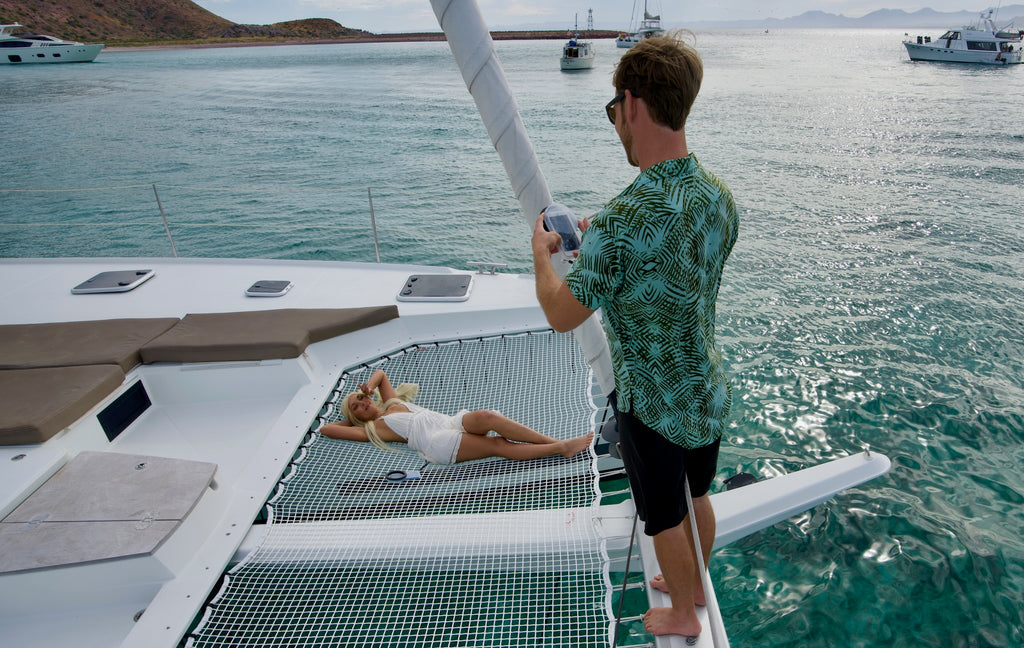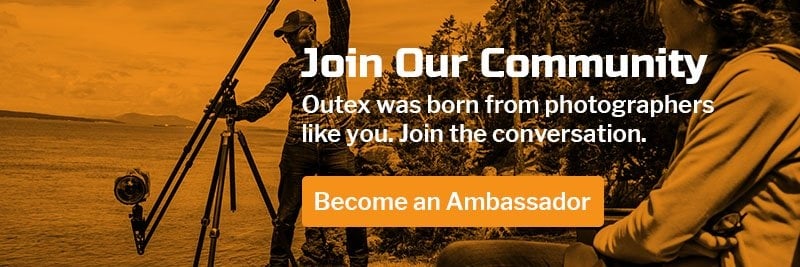Top 10 Outex Tips & Tricks for Underwater Phone Photography
"The best camera is the one you have with you!" As camera phones continue to improve at a rapid pace, they are not only convenient, but powerful photography tools, increasingly making their way into professional's workflows. Even more convenient than action cameras/GoPros, your phone is always with you, has more optical and software capabilities, and is ready to edit and share your creative results - all in one device. They are expensive, and hold a lot of important information, so it's important to protect them in adverse environments. And while they offer good protection against the elements on their own, it's better to know this important device is fully protected in any environmental condition, even during long periods underwater. This guide helps you borrow proven imaging tricks, tips, and techniques that will improve your image capture, whether it's still photography or video.
-
Optimize camera function access.
Treat your phone like a camera. Think, hold, and operate it like a camera rather than a phone. Remove other cases. Removing other cases before inserting the phone into a housing or cover, makes it easier to insert it, and facilitates access to the important hard/side trigger buttons for photos & video – especially underwater.

Phone side buttons are preprogramed to trigger your camera/video shutter button. This enhances ergonomic stability and control of the device, and it feels and behaves more like a camera. Utilizing these controls allows you to use both hands for stability, and gives you increased control, visibility, and functionality over functions on the screen, including selfies. This is also true for the Outex phone system.

Installation video from Outex.com and YouTube channel
-
Use a mask or goggles.
Using a mask or goggles underwater will help you see the overall composition of the scene or shot, as well as the subject matter on the phone’s screen underwater. Masks can help prevent water from going into your nose if you're not accustomed to underwater photography, but goggles are small and lightweight, so they can pack as easily as your phone and housing. Clear visibility will help you in every way, just as it does above water.



-
Block other apps.
Keeping the phone “locked” to other apps by accessing the camera directly from the locked screen will prevent other apps from interfering during your photoshoot. When you unlock the phone, you’re more likely to accidentally press other buttons, or trigger unwanted applications. There’s a camera direct-access button on most phone lock screens. Use it to gain access to the camera functionality only. It will save you time and hassle during camera operation – especially underwater, where the water pressure may inadvertently trigger unintended phone activity. There are different ways to do this, and phones can vary, but they are fast and convenient once you know them. Here are two examples from the iPhone.

In the first scenario the camera button is on the locked screen. Don't unlock the phone. Press & hold the camera button directly from the locked screen.

Alternatively, you can pull down the control panel screen, and access the camera button before going underwater. This also accesses the camera without unlocking the phone and enabling other apps.
-
Use hard/side buttons underwater
While you can still access touch screen controls above water, they don’t work underwater because the water’s pressure against the cover and screen surface confuses the phone’s sensors. This is normal. While in camera mode, use the hard/side camera shutter buttons to trigger the camera’s functions. Most phones come pre-programmed this way, and you can check your camera settings to make adjustments based on preferences. Your volume up & down buttons can operate as triggers, and you can customize/change their functions in various ways. For example, the iPhone’s volume up buttons triggers a photo when pressed once. If you press & hold it will switch to video and begin recording. Pressing it again will stop recording. Similar settings will allow you to capture “Live” photos or toggle between functions. Research your phone’s features if you wish to optimize it.

-
Mind your surroundings
As with any photography, you decide what’s best. It’s important to take stock of underwater realities for underwater imaging. Things to consider will include lighting, clarity of the water, distances, and other variables such as blowing bubbles, hair getting in the way, etc. Take advantage of weightlessness to explore a 3-dimensional view of your subject. Underwater you can be above, below, and all around them, making it much easier to find the proper framing, lighting conditions, and getting the images to conform to your creativity. Always be safe, especially in new, unknown environments. Think thru what you want to accomplish and the safest way to accomplish it beforehand. Take advantage of the wrist strap to prevent dropping, losing, or damaging the phone itself. The Outex kit floats on its own, but phones vary in weight and can sink the case. Use the strap at all times. More trapped air inside helps flotation. And the dome lens traps enough air to float virtually all phones.


-
Review your work.
Whether above or underwater it’s important to maximize your visibility of the environment and what’s in the frame. Playback your images to review your work as you go. Shade the viewing screen outside or in direct sunlight when needed to help you see it. Use your hands or your own body to create shade. Practice makes perfect. Take multiple shots to help ensure you minimize numerous variables such as closed, squinting eyes, hair in your face, blowing bubbles, wardrobe optimization, etc.


-
Dome Magic
Dome lenses correct underwater imaging aberrations that happen underwater as light travels at different speeds over air vs. water. Think of a pencil that appears broken when dipped into a glass of water. Domes are ideal for split-level, half over half underwater photos, specifically because they correct those magnification and separation aberrations. They are especially effective in wider angle situations, for that sensational split-level look so many people enjoy. In addition, the domes trap air inside the Outex system, making it float in the water. And the dome also accommodates external accessory lenses you can attach to the phone inside the Outex housing.


Example Videos from the Outex YouTube channel
-
Reduce water droplets & fogging
Keeping in mind that sometimes water droplets on the port surface are desirable and can create magical light effects from reflection and refraction, we’re going to focus on removing them here. Flat Outex optical glass ports are pre-treated with water-repelling nano-coatings that help wick water away, so it will flow down and out of the field of view. But it may not eliminate it. Saliva/spit can help prevent water droplets from accumulation on the front/outside of the Outex lens. You may also use 3rd party water-repellents such as Rain-X or Clarifii as desired. Domes are not treated with nano-coating on purpose. Their curved shape creates irregular flows on its face, and nano-coating it would be less effective than using a different technique that maintains a thin film of water on it to allow the camera to focus thru it. By applying spit/saliva evenly onto the dome, cohesive forces will keep a thin layer of water over the port surface long enough after a quick dip to enable the user to capture images thru it. You can repeat the water dip a few times without having to re-coat the port. But will need to eventually re-apply if you continue to use it for extended periods of time.

Fogging is a different phenomenon altogether and happens from the inside as the mobile phone generates heat. Over time the heat converts the trapped moisture gas into condensation. Different phones generate different amounts of heat depending on mode of operation and settings. For example, video recording is more intensive than still photography. Things you can do to reduce fogging include:
- Avoid direct sunlight for extended periods, or abrupt temp changes.
- Stop all the apps, cease operation, turn it off, let it cool. Cold water outside the housing can help keep the phone cool while in use.
- Open the housing to “vent” it. Cooler air has less moisture than warmer air. Creating a seal in a cool, dry place is better than in a hot, moist environment.
- Consider using a moisture-wicking desiccant pack inside the housing. They are readily available worldwide.

-
Communicate with your subject.
Communicating with your subject can be very helpful, and people often underestimate the importance of providing guidance, direction, and feedback in a constructive, descriptive manner. If you’re visualizing certain results, let the subject know what you're thinking and your rationale. It's best to start communicating in advance of the actual shot, so the "model" knows your creative vision in advance, and the kind of results you have in mind. Set expectations and provide guidance. Review the shots with them so they can see what you see and how you'd like to improve it. It's helpful to lead with positive feedback first, before directing them on ways to improve. Everyone likes feeling appreciated, and are likely to receive constructive criticism when they understand your creative objectives.


-
Maximize the use of accessory tools
There's no shortage of third party accessories aimed at improving your imaging work. From tripods and stabilizers, external lenses, and lights, to wireless triggers and gimbals. They can be valuable when utilizing powerful imaging techniches such as time lapse, slow motion, burst, and aerial photography such as drones. Keep all this in mind when selecting your underwater housing system. You'll probably want something that is modular, compatible, and lightweight, while enabling you to utilize many of these photo accessories.
Like the Outex camera products, the phone system is designed to provide the best optical performance while maintaining a universal-compatible design, and lightweight, compact design. The patented design takes advantage of a large optical glass port for optimal viewing placement and resolution. And the dome port can accommodate third party, external lenses for wide-angle, zoom, macro, or specialty lenses. It also allows the build in flash to function. The stretchy malleable cover/housing/case gives tactile feedback on the hard buttons, maintains touchscreen functionality, and accommodates spring-loaded or adjustable mounts that can be attached to tripods, drones, gimbals, etc. It also maintains your phones wireless capabilities for remotes, triggers, wi-fi, infra-red (IR), radio-frequency (RF), and bluetooth protocols.


Bonus; Maintenance & Care for the Outex underwater camera phone gear
Similar to your camera systems, the Outex camera phone covers are designed to last years when properly maintained. They are rugged and resilient to the elements, and can withstand plenty of use over time in both extreme dessert heat or under ice water. Treat it as you would your phone. The optics are made of sturdy metal and clear optical glass materials. The cover is a patented, silicone based material that has been perfected over time to optimize the balance of control, tactile feedback, transparency, and ruggedness.
Like your phone, the Outex system can break/tear if dropped from a certain height/distance. The glass can break or the cover can tear/rip when enough pressure is applied with sharp objects. You can replace the individual components (ports, cover, straps, etc.) by shopping for individual PARTS in the Outex online PRODUCT store.
Treat your Outex camera phone system like your skin or hair. Rinse them in clean tap water and mild soap after use to remove sand, dirt, grit, or other residue that may lodge in the threads, or cover itself, inside and out. The cover is porous to assist tactile response and can retain dirt or discolor over time if not cleaned after use. You can used an old toothbrush or cue tip for the threads and channels. Towel dry the parts when done, inside and out, then let it air dry so the rest of the moisture can evaporate from hard to reach places.
Keeping it clean and storing it in a cool, dry place when not in use will increase longevity and prevent discoloration of the cover over time. For additional information, consult the Outex website Questions pages/menu, or use the site's keyword search feature by typing the desired reference word into the "looking glass" icon.



